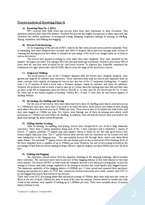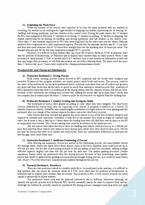2. Productivity and Financial Bottlenecks
3. Short Term Analysis
4. Long Term Analysis
5. Conclusion
A) Receiving Plant No. 1 (RP1)
RP1 received both fresh fruits and process fruits from early September to early December. This operation involved more than 400 workers. However the process was highly mechanized in many ways and was classified into several operations: receiving and testing, dumping, temporary holding, de-stoning, de-chaffing, drying, separation, and bulking and bagging.
B) Process Fruit Receiving
At the beginning of the process of RP1, bulk trucks that carry process berries arrived randomly. Prior to unloading, they were weighted and recorded, and 30lbs of samples which had been through small version of cleaning and drying process were taken to estimate the percentage of the truck’s net weight made up of clean as well as dry berries.
The berries were graded according to color while they were weighted. They were classified by the number: the higher the better. For example #3 is the best and would get a premium. However only about 50% of them were #3, and they were accepted by the chief berry receiver. To improve this, Schaeffer considered the installation of a light system that costs $10,000, which is also the wage of the chief berry receiver.
C) Temporary Holding
The truck moved to one of the 5 Kiwanee dumpers after the berries were weighed, sampled, color graded and emptied its contents onto conveyors. These conveyors then took the berries and deposited them on other conveyor belts capable of running the berries into any one of the 27 temporary holding bins. It usually took 5 to 10 minutes to back a truck onto a Kiwanee dumper, empty its contents, and leave the platform. However the problem is that at times, it had to wait up to 3 hours when the holding bins were full and there was no place in the RP to temporarily store the berries. Bins #1 to 16 were only for dry berries and #17 to 24 were for either wet or dry berries capable of holding 250bbls. #25, 26 and 27 were only for wet berries capable of holding 400bbls.
D) De-stoning, De-chaffing and Drying
For the case of wet berries, they were taken directly to three de-chaffing units which could process up to 1,500bbls per hour each. Since there is no need to de-stone wet fruits, these berries were taken to three drying units where they were dried at rates up to 200bbls per hour. These berries were to be loaded into bulk trucks, and they were bagged at 150bbls per hour. Dry berries went through one of three de-stoning units which could process up to 1,500bbls per hour before de-chaffing. In addition, both wet and dry berries were processed at the same time through the same system frequently.









 분야
분야


